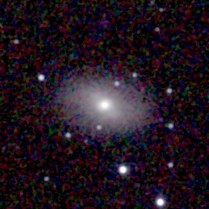NGC 7079
| Galaxy NGC 7079 |
|
|---|---|

|
|
| AladinLite | |
| Constellation | crane |
|
Position equinox : J2000.0 , epoch : J2000.0 |
|
| Right ascension | 21 h 32 m 35.2 s |
| declination | -44 ° 04 ′ 03 ″ |
| Appearance | |
| Morphological type | (L) SB (r) 0 ^ 0 / LINER |
| Brightness (visual) | 11.6 mag |
| Brightness (B-band) | 12.5 mag |
| Angular expansion | 2.0 '× 1.2' |
| Position angle | 82 ° |
| Surface brightness | 12.6 mag / arcmin² |
| Physical data | |
| Affiliation | SSRS group 34 NGC 7079 group LGG 446 |
| Redshift | 0.008953 ± 0.000053 |
| Radial velocity | 2684 ± 16 km / s |
|
Stroke distance v rad / H 0 |
(119 ± 8) · 10 6 ly (36.6 ± 2.6) Mpc |
| history | |
| discovery | John Herschel |
| Discovery date | September 6, 1834 |
| Catalog names | |
| NGC 7079 • PGC 66934 • ESO 287-036 • MCG -07-44-022 • 2MASX J21323526-4404029 • SGC 212922-4417.3 • GALEX ASC J213235.27-440402.9 • LDCE 1468 NED003 | |
NGC 7079 is a lenticular galaxy with an active nucleus of the Hubble type SB0 in the constellation Crane in the southern sky . It is estimated to be 119 million light years from the Milky Way and about 70,000 light years across.
Together with NGC 7070 , NGC 7097 , NGC 7107 , PGC 66909 , PGC 66985 , PGC 67078 and PGC 67160 , it forms the NGC 7079 group or LGG 446 .
The object was discovered by John Herschel on September 6, 1834 .
NGC 7079 group ( LGG 446 )
| Galaxy | Alternative name | Distance / million Lj |
|---|---|---|
| NGC 7079 | PGC 66934 | 119 |
| NGC 7070 | PGC 66869 | 106 |
| NGC 7097 | PGC 67146 | 117 |
| NGC 7107 | PGC 67209 | 98 |
| PGC 66909 | NGC 7070A | 107 |
| PGC 67160 | NGC 7097A | 116 |
| PGC 67078 | ESO 287-043 | 110 |
| PGC 66985 | ESO 287-037 | 116 |
